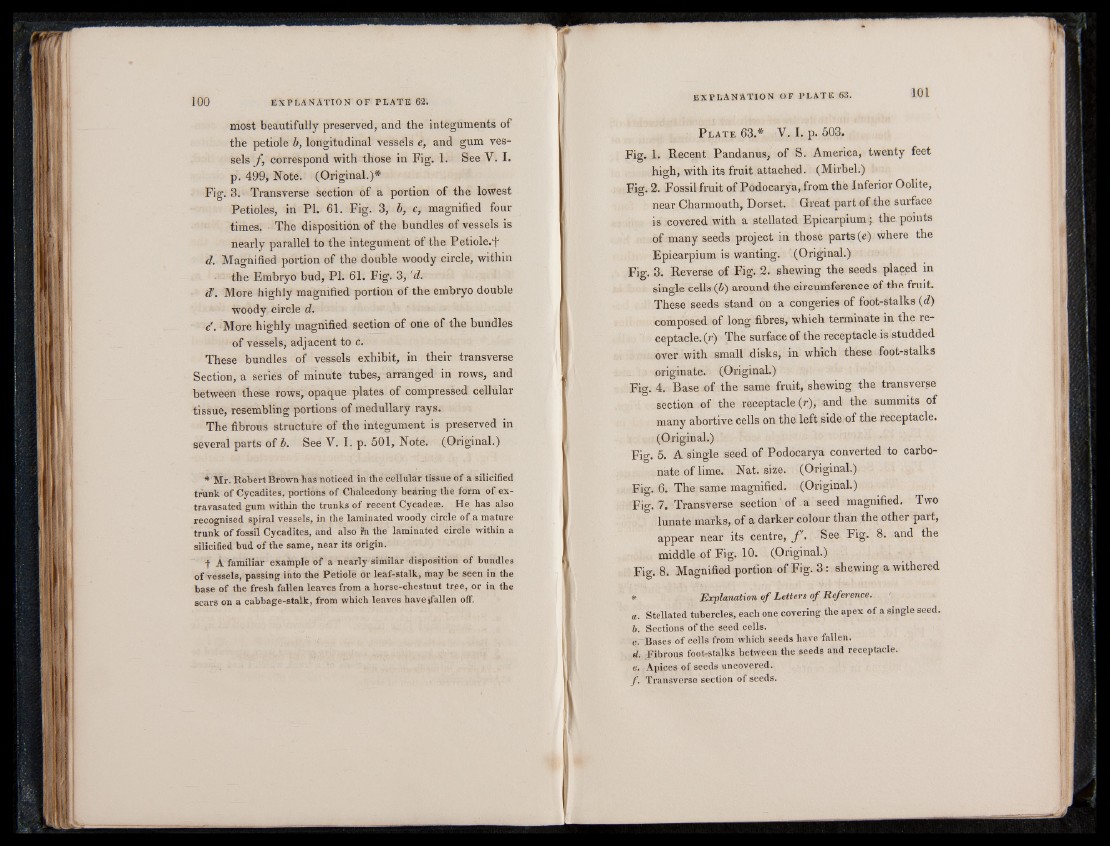
most beautifully preserved, and the integuments of
the petiole b, longitudinal vessels e, and gum vessels
f , correspond with those in Fig. 1. See V. I.
p. 499, Note. (Original.)*
Fig. 3. Transverse section of a portion of the lowest
Petioles, in PI. 61. Fig. 3, b, c, magnified four
times. ■ The disposition of the bundles of vessels is
nearly parallel to the integument of the Petiole.f
d. Magnified portion of the double woody circle, within
the Embryo bud, PI. 61. Fig. 3, 'd.
d!. More highly magnified portion of the embryo double
woody circle d.
c\ More highly magnified section of one of the bundles
of vessels, adjacent to c.
These bundles of vessels exhibit, in their transverse
Section, a series of minute tubes, arranged in rows, and
between these rows, opaque plates of compressed cellular
tissue, resembling portions of medullary rays.
The fibrous structure of the integument is preserved in
several parts of b. See V. I. p. 501, Note. (Original.)
* Mr. Robert Brown has noticed in the cellular tissue of a silicified
trunk of Cycadites, portions of Chalcedony bearing the form of ex-
travasated gum within the trunks of recent Cycadeae. He has also
recognised spiral vessels, in the laminated woody circle of a mature
trunk of fossil Cycadites, and also fn the laminated circle within a
silicified bud of the same, near its origin.
-j- A familiar example of a nearly similar disposition of bundles
of vessels, passing into the Petiole or leaf-stalk, may be seen in the
base of the fresh fallen leaves from a horse-chestnut tree, or in the
scars on a cabhage-stalk, from which leaves have »fallen off.
P la t e 63.* V. I. p. 503.
Fig. 1. Recent Pandanus, of S. America, twenty feet
high, with its fruit attached. (Mirbel.)
Fig. 2. Fossil fruit of Podocarya, from the Inferior Oolite,
near Charmouth, Dorset. Great part of the surface
is covered with a stellated Epicarpium; the points
of many seeds project in those parts (e) where the
Epicarpium is wanting. (Original.)
Fig. 3. Reverse of Fig. 2. shewing the seeds placed in
single cells (b) around the circumference of the fruit.
These seeds stand on a congeries of foot-stalks (d)
composed of long fibres, which terminate in the receptacle.
(r) The surface of the receptacle is studded
over with small disks, in which these foot-stalks
originate. (Original.)
Fig. 4. Base of the same fruit, shewing the transverse
section of the receptacle (r), and the summits of
many abortive cells on the left side of the receptacle.
(Original.)
Fig. 5. A single seed of Podocarya converted to carbonate
of lime. Nat. size. (Original.)
Fig. 6. The same magnified. (Original.)
Fig. 7. Transverse section of a seed magnified. Two
lunate marks, of a darker colour than the other part,
appear near its centre, f . See Fig. 8. and the
middle of Fig. 10. (Original.)
Fig. 8. Magnified portion of Fig. 3: shewing a withered
* Explanation o f Letters of Reference.
a. Stellated tubercles, each one covering the apex of a single seed.
b. Sections of tbe seed cells.
c. Bases of cells from which seeds have fallen.
d. Fibrous foot-stajks between the seeds and receptacle.
e. Apices of seeds uncovered.
f . Transverse section of seeds.